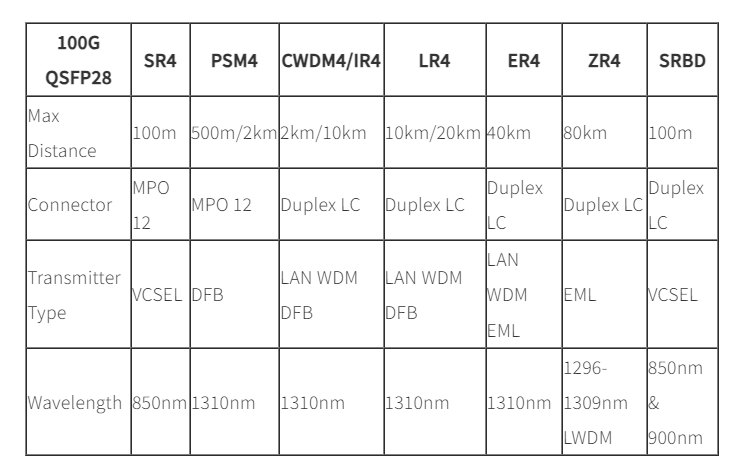

 Knowledge Base +
Knowledge Base +  2023.12.04
2023.12.04The maximum distance for QSFP28 (Quad Small Form-factor Pluggable 28) transceivers can vary depending on the type of optical fiber and the specific module used. Generally, the maximum distance for QSFP28 transceivers can range from 100 meters to 10 kilometers, depending on factors such as the type of fiber, transmission speed, and module specifications. It is important to consult the specific datasheet and specifications of the QSFP28 transceiver being used to determine its maximum distance capability.

How to Select the Best 100G QSFP28 Optics?
Now that we know we have to choose the best 100G optics based on our actual demand, but how? How can we choose the right one? Here is a selection guide for you.
For transmission distances between 5m and 100m, you can choose the QSFP28 SR4 optical transceiver module. It can transmit 70m using OM3 fibers or 100m using OM4 fibers.
For transmission distances between 100m to 2km, QSFP 100G PSM4 or QSFP28 CWDM4 modules would be better. The cost of QSFP28 CWDM4 is much higher than the QSFP28 PSM4. However, the QSFP28 CWDM4 requires only two single mode fibers in two-way transmission which is much less than the eight single mode fibers of QSFP28 PSM4, and the total cost of the QSFP 100G PSM4 rises very quickly. In practical applications, it is necessary to decide whether to use QSFP28 PSM4 or QSFP28 CWDM4 depending on the interconnection distance.
For transmission distance between 10km to 40km, you can consider QSFP 100G LR4 which has a maximum transmission distance of up to 10 km, or QSFP28 ER4 transceivers which can reach up to a maximum transmission distance of even further—40km.
100G QSFP28 Definition
The 100G QSFP28 optical transceiver is designed for 100 Gigabit Ethernet, EDR InfiniBand, or 32G Fibre Channel. It generally has the exact same footprint and faceplate density as 40G QSFP+. Just as the 40G QSFP+ is implemented using four 10Gbps lanes, the 100G QSFP28 module is implemented with four channels of high-speed differential signals with data rates ranging from 25Gbps up to potentially 40Gbps. With an upgraded electrical interface, the QSFP28 100G transceiver is capable of supporting signals up to 28Gbps. QSFP 100G SR4, QSFP 100G LR4, QSFP 100G PSM4, QSFP 100G CWDM4, and QSFP 100G ER4 are the five common types of 100G QSFP28 modules designed to meet the different transmission distance requirements. Compared with 100G CFP/CFP2/CFP4 transceivers, QSFP 100G optics surpass them with the strong ability to increase density, decrease power consumption, and decrease the price per bit.
QSFP28 100G Module Standards
The 100G QSFP28 optical module standards are mainly defined by two key organizations, namely IEEE and Multi-Source Agreement (MSA). The QSFP28 SR4, QSFP28 LR4, QSFP28 ER4 are defined by the IEEE. How to clarify these three items from their names? The ‘QSFP’ means the form factor; ‘28’ represents that each lane has a maximum transmission rate of 28Gbps; ‘SR’ means short reach (100m), ‘LR’ is long reach (10km) and ‘ER’ is extended reach (40km). ‘4’ represents that the module has 4 lanes. For example, the QSFP28 LR4 means that it is a long-reach 100G module that can transmit 100G signals over four wavelengths with a transmission distance of 10km.
100GBASE-SR4 and 100GBASE-LR4 are the most commonly used 100G interface specifications defined by the IEEE. However, the transmission distance of QSFP28 SR4 is too short to meet all interconnection requirements and the cost of QSFP28 LR4 is too high for large data centers. Therefore, MSA brought a solution for mid-range connectivity to the market and defined the standards of QSFP28 PSM4 and CWDM4. Although the capability of QSFP 100G LR4 completely covers QSFP28 CWDM4, but the QSFP 100G CWDM4 solution is much cheaper and more competitive than QSFP28 LR4 in the scenario of 2km transmission.
Subscribe to the newsletter
for all the latest updates.
2-5# Building, Tongfuyu Industrial Zone, Aiqun Road, Shiyan Street, Baoan District, Shenzhen. China
